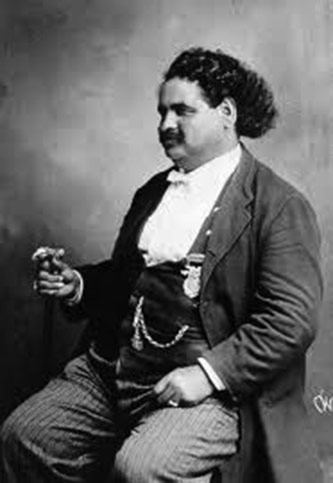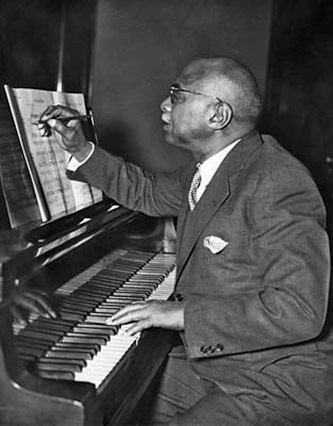American Music Review
Vol. XLII, No. 1, Fall 2012
By Edward A. Berlin
John William Boone (1864–1927), known as "Blind Boone," was a prodigiously talented African American pianist and composer. As an infant he developed what was known as "brain fever"; a Union army surgeon treated him with the then-standard procedure of removing his eyes. Boone went on to have an illustrious career and a life of fulfillment. As a fifteen-year-old, he entered into what was to be a lifelong professional and personal alliance with John Lange, Jr. (1840-1916). Lange had been born a slave but developed into a shrewd business man who nourished Boone's talent and helped him develop his artistic talents. Boone married Lange's youngest sister in 1889.
Boone was originally promoted as a competitor to and successor of Thomas "Blind Tom" Wiggins (1849-1908), an African American pianist-composer who was frequently portrayed as a miraculous freak, but who was probably an autistic savant of limited abilities outside of music. Boone and Lange, choosing not to exploit his blindness, adopted the motto "Merit, Not Sympathy, Wins." Boone went on to have a prosperous career, even becoming known in his native Missouri as a local philanthropist. His concerts—an announced 7,200 by 1913—featured standard repertory by Beethoven, Chopin, Liszt, and Gottschalk, along with his own virtuoso piano pieces and songs based on African American folk melodies. His reputation survives to the present day because of his published compositions and piano rolls. He is celebrated annually in Columbia, Missouri, with a Blind Boone Ragtime and Early Jazz Festival.
 blindboonehome.com">
blindboonehome.com">
John William Boone ("Blind Boone"), courtesy of blindboonehome.com
In 1915, Lange commissioned Melissa Fuell, a vocalist with the Blind Boone Concert Company, to write Boone's biography. The first edition of the book was issued the same year with the title Blind Boone: His Early Life and His Achievements. The second edition, reviewed here, was published in 1918, after Lange's death (and after Fuell had married, changing her name to Fuell-Cuther). The book's overly worshipful tone toward Boone and Lange can be difficult to take at times, but as Fuell had complete access to the principals it forms and remains a major source of information about Boone and the musical and cultural scene in which he lived. The book is appended with lyrics and music of several of Boone's songs and two of his elaborate piano scores—Old Folks at Home: Grand Fantasie and Grand Valse de Concert—works that place him well within the virtuoso tradition of 19th-century America.
In the current reprint, Merit, Not Sympathy, Wins: The Life and Times of Blind Boone (Truman State University Press, 2012), editors Mary Collins Barile and Christine Montgomery enhance the value of the original text immensely with meticulous annotation in page-bottom footnotes. Using historical newspapers, public records and other sources they elucidate the text with identifications and discussions of the various individuals and institutions mentioned and clarify historical events. Added to these annotations are a group of excellent essays. Mike Shaw and Christine Montgomery round out the biography with a summary of Boone's story after Fuell-Cuther's 2nd edition; Max Morath provides a foreword that compares Boone's life and career with that of Scott Joplin (ca. 1867-1917); pianist John Davis, who has recorded Boone's works, examines the music; Greg Olson and Gary R. Kremer discuss Missouri during Boone's and Lange's years; and Marilyn Hillsman and Mary Barile write of Melissa Fuell-Cuther and her connections with Boone. This is a model, exemplary reprint.
 themusicisover.com">
themusicisover.com">
W.C. Handy composing at the piano, courtesy of themusicisover.com
Whereas copies of Boone's biography had become difficult to find prior to the current reprint, W. C. Handy's Blues, An Anthology (1926) has been available in various editions issued in 1949 (renamed Treasury of the Blues), 1972 (reverting to the original title), 1985, and 1990. Consequently, one is justified in wondering about the need for yet another edition. Elliott S. Hurwitt, compiler of the new, expanded edition of W. C. Handy's Blues, An Anthology. Complete Words and Music of 70 Great Songs and Instrumentals (Dover Publications, 2012) makes a compelling case.
The first edition grew out of a friendship between Handy and music-loving Wall Street lawyer Abbe Niles. As Handy responded to Niles's questions about the blues, the book gradually emerged, with Handy providing the music and Niles writing an outstanding, pioneering introduction on the blues, along with notes about the individual selections. Miguel Covarrubias was brought aboard to provide vivid, idiosyncratic pictorial illustrations.
"Memphis Blues" by W. C. Handy, recorded by Victor Military Band, 15 July 1914
In the original edition, the musical contents begin with thirteen folk blues, notated and arranged by Handy. These are followed by thirty composed blues, thirteen by Handy, with the balance including songs by such composers as Spencer Williams and Will Nash. Missing are a number of key pieces by Handy, including "Memphis Blues," "Yellow Dog Blues," "Beale Street Blues," "Shoeboot's Serenade," and "Ole Miss." Handy had been deceived into selling his copyright for "Memphis Blues," and had sold the others when in financial need. The volume also has material that might be considered outside the proper realm of blues, introduced to show the influence of the genre. These include such popular songs as Jerome Kern's "Left All Alone Again Blues," Irving Berlin's "The Schoolhouse Blues," Gershwin's "The Half of It, Dearie, Blues," and piano reduction excerpts of Gershwin's Rhapsody in Blue and Concerto in F and John Alden Carpenter's ballet Krazy Kat. Despite the absence of major Handy pieces, the original edition of fifty selections received glowing reviews and became an influence on the writers of the Harlem Renaissance.
By the time of the 1949 edition, now titled A Treasury of the Blues, Complete Words and Music of 67 Great Songs from Memphis Blues to the Present Day, Handy had recovered his copyrights and included his previously omitted blues compositions. He deleted the Gershwin, Kern, Berlin, and Carpenter works, but added other thenpopular, blues-influenced songs like "Willow Weep for Me" and an excerpt from Ellington's "Mood Indigo." The Covarrubias drawings were retained and Niles updated his essay and selection notes accordingly.
The 1972 edition reverted to the original title, deleted the pop songs that had been added in 1949, reduced the musical content to fifty-three selections, and Jerry Silverman added guitar chords to most pieces. The 1985 and 1990 editions are both reprints of the 1972 edition, the 1990 having a new introduction by William Ferris (retained in the 2012 edition).
For the current, 2012 edition, Hurwitt restores important blues that appeared only in the 1949 edition, including "Baby Seals Blues" (1912), "Dallas Blues" (1912), "Long Lost Blues" (1914), and "Rice Hotel Blues" (1915). He adds other early, significant pieces that relate to Handy's and Niles's own selections: "The Blues (But I'm Too Blamed Mean to Cry)" (1912), "New York Tango Blues" (1914), "A Bunch of Blues" (1915), and several others, bringing the new total to seventy pieces.
Hurwitt's nine-page introduction presents a brief history of the blues and its evolution through the decades, including references that pre-date the beginning of blues publishing in 1912. He relates Handy's story and his role in the history of the blues, how the 1926 publication came about and how it changed in its various editions, Niles's essential part in the publication, and the importance of his essay analyzing the history and structure of the blues. Hurwitt's introduction, and his musical restorations and additions, increase immeasurably the usefulness of W. C. Handy's historic volume.






